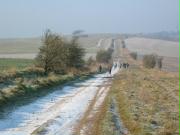
CYHA News
The Monthly Newsletter of Chelmsford YHA Local Group
March 2006
Welcome the Spring

It's been a cold, dry winter and at long last it seems to be giving way to new green shoots of Spring. Just to remind us of the dark times we're leaving behind, please enjoy Trudi's cultural tribute to Daniel Defoe on the back page.
Hostel closures have been very much in the news of late as YHA try to come to terms with their over-extended finances. Jim and Dave P recently attended a meeting in South Ken where YHA attempted to put their side of the story to some of our impassioned local group brethren, please see below for a brief report.
We also have from John M, a historical take on our recent Frankfurt trip.
Ali
Cold Winds on the Ridgeway

Some might disagree, but I think luck was with us for the Ridgeway weekend. It was bitterly, bitterly cold, but on the plus side we had blue skies and wonderful views, particularly on the Sunday.
Saturday saw us walking from Ridgeway hostel, along the ancient trackway to the White Horse at Uffington, and for some along further to Waylands Smithy, one of the most impressive and atmospheric Neolithic burial chambers in Britain. En route we passed frosty grass, frozen puddles, stiff little mole bodies pinned to a barb wire fence, flicking in the cold wind and even an icecream van trying to drum up some trade.
Sunday's walk on Inkpen Hill in the Berkshire Downs gave us some more fine views. It was if anything colder, but we survived long enough to make it to the luxury teashop in Hungerford.
Ali
Winter in Frankfurt
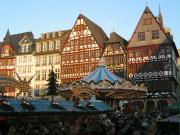
In November last year eight members of the group spent a long weekend in Frankfurt-am-Main, guests of Geli who recently moved there following several years of teaching in England. The weekend was great fun and a good respite for all of those who participated. We met up at Stansted Airport on Friday morning and flew to Frankfurt Hahn. This proved to be a small but welcoming airport and is the only one I have come across that is named after a domesticated fowl ('Hahn' apparently means 'chicken' in German.) From here we bussed into Frankfurt and made our way to the Hostel. This had the somewhat classical name of 'House of Youth' emblazoned across its lintel, which conjured up images of Plato's academy. Seeing this name put me in a good mood as a few days earlier I had received an unsolicited Saga brochure in the post, the holidays of which I am certainly not ready to consider yet. The hostel is a sizeable establishment and even at that time was full, with students doing winter sight-seeing.
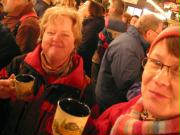
After claiming our rooms we headed into town. Crossing an imposing bridge over the River Main we made our way to our meeting point, met Geli and then wandered into the Christmas fayre. This is quite a celebrated event and my first experience of this type of fayre, which are popular across Germany and some other countries in Europe. There were many stalls selling tasty snacks, traditional Christmas gifts (not a stall selling Walkmens in sight, thank goodness) and rejuvenating tumblers of gluwein - hot mulled wine just the required drink for the wintry evening.
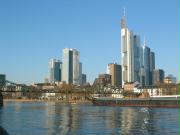
On Saturday we saw the fayre in the daytime and then ascended Frankfurt tower, a modern business skyscraper which offers commanding views of Frankfurt and the Taunus hills. Moving on, we used the city's fine metro transport to travel to Bad Homburg. We registered in the hostel there, which was less busy than Frankfurt but just as well appointed.

Bad Homburg is a spa town on the outskirts of Frankfurt and was popularized by the Prussian and Bavarian royal families in the later 19th century, who travelled there for the waters in the same way our Queen Victoria visited Malvern and Bath. The town is a nice mixture of old and new and is dominated by a castle which had its own mini-fayre. A scaled railway was there also, ferrying passengers round a folly in the middle of the castle courtyard. We also had an opportunity to visit the hall where in the great 'peoples spring' of 1848 liberals had declared Germany to be a united country, a step in the creation of Germany as a unified state.
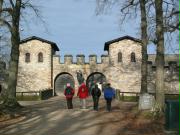
Sunday morning saw us, at Geli's suggestion, taking the bus out into the Taunus hills to the old Roman limes, or frontier. Here there is the Roman fortress once garrisoned by the legion that guarded this frontier. It was reconstructed in the 1900s by the Kaiser and covers several acres. The walls, rebuilt in a good conjecture of the original style, stand fifteen feet tall and when we were there loomed eerily out of the crisp wintry day in the same way that the original walls must have nineteen centuries ago.
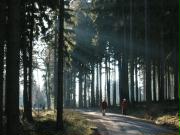
We then walked through the forest, following the remains of the ditch and vallum that extended across this part of Germany and that marked the border between the Pax Romanum and the world beyond. This border is where Rome retreated to following the disaster of AD9, when three legions under the Tribune Varus, bent on subduing Germany, were annihilated by tribesmen in the depths of the forest. Suetonius gives a succinct account of the aftermath of the disaster in his Lives of the Caesars where he records Augustus, unshaven, unkempt and temporarily insane, wandering round the Leontine Palace shouting 'Quintillius Varus, give me back my legions!' while terrified flunkies hid and panicking generals scrabbled through muster lists to throw together a hodgepodge of troops from across the Mediterranean to fill the gaping ulcer in the Empire's flank.
Our revictualling halt in the Taunus forest was at a pleasant restaurant serving delightful plates of sausages and steaming cups of tea. This too had an imposing tower, built in the early 1900s in a style reminiscent of a Roman signal tower and which loomed above the forest. The view from the base alone commanded good views of the area and made us appreciate the rolling but splendidly forested topography of the Taunus. It is good that this has been preserved on the doorstep of Frankfurt for locals and foreigners alike to spend their leisure time in..
Monday saw us returning to Frankfurt and bussing to Hahn Airport for the journey home. A very good weekend. We saw far more than any of us had expected. Thanks to Geli for inviting us to her new home city and for guiding us through its many sights. Thanks also to Jim for organizing the flights and for Geli and Jim for their translation work..
John Maton
A Journal of the Plague New year
being Observations of Memorials of the most Remarkable Occurrences, as well as Publick as Private, which happened in Derbyshire during the last Great Visitation in 2005/6.
Written by a Citizen who Continued all the while in Derbyshire.
It was on arrival at Glenbrook that I, amongst the rest of my travellers, heard, in ordinary discourse, that the Plague was returned again in Derbyshire. Some said it was brought from Essex, others from Cyprus. It mattered not from whence it came, but all agreed it had come to Eyam again.

Five cases were early reported at the Glenbrook Centre, where some people shared great concern and the parish clerk was early indisposed (Dave Plummer). However, as the weather was temperate, variable and cool enough, others had some hope that the contagion would not afflict them (Trudi).
But if the plague begins in a close knit community and gets a head, there its fury increases, it rages over the place, and consumes all it can reach. The danger spread imperceptibly as many people never perceived that they were infected. The apothecaries know not how to separate the sick from the sound.
My friend Cressida Alderson was of the opinion that it might be known by their smell, but who durst smell them for this information? since, to know it, he must draw the stench of the plague up into his own brain, in order to distinguish the smell! Many people had the plague in their very blood and preying upon their spirits, and were but walking putrefied carcasses, whose breath was infectious and sweat poison. Some, having been well to the best of their own judgement, apart from a decay of appetite and a light sickness upon their stomachs, had been breathing death particularly during the tender kissing and embracing of New Years Eve celebrations. The acute penetrating nature of the disease was such, and the infection received so imperceptibly, that the most exact caution could not secure us whilst in that place. It proved impossible to prevent the spread by the utmost human vigilance (disinfection of surfaces and door handles). People talked of the air being corrupted and infected and drawing in disease when they breathed.
The plague operated in a different manor on different constitutions. Some were immediately overwhelmed with it, whilst others were silently infected, the fever preying upon their spirits insensibly. The best physic against the plague was to flee (Colin), but some fled too late and after having the taint of the disease in their vitals.
Notice was given of the sickness and the goods and stuff of the infection sequestered and aired. The shutting up of dormitories was considered, but the continuance of the visitation persuaded us that Divine Providence only could prevent it.
However, the contagion did prove short lived. For it must be observed that where the plague was in its full force, there indeed the People were very miserable, and the consternation was inexpressible. But after it was gone, they were quite another sort of people. And I cannot but acknowledge that there was too much of that common temper of mankind to be found amongst us all that time, namely to forget the deliverance when the danger is passed.
But I shall come to speak of that part again…
Trudi Warner - after Daniel Defoe "A Journal of the Plague Year" published 1722.
The End of Hostelling As We Know It?
In announcements over the last few months, YHA have listed 50 hostels which will close, including some of our favourites from around the country. Dave P and Jim went to the YHA's presentation and Q & A session about their future strategy at YHA South Kensington on 2nd February.
For the YHA there were Roger Clarke, the CEO, Alan Bourne (Treasurer) and James Blake, a trustee. They went over the strategy with the key points coming up:
- YHA currently just about breaking even on day to day running, but servicing £30-odd million debt. Not enough put by for repairs or investment.
- Have already tried to eke most out of current network and can't make more money, by marketing, and getting more money out of customers by selling meals etc. Currently on about 45% occupancy across the network up from 40% a few years ago, but need 50% plus to be financially secure.
- Their market research identifies 3 target markets, none of which we fit: Families with young children, Young independent, often from overseas, schools and youth groups.
- Closing 32 hostels over the next couple of years; mainly those with low occupancy 10-30% and/or where a big investment is needed for repair or to bring up to current standards.
- Brunt of closures is medium hostels (40-80 beds), as big ones have economy of scale, and small ones cheap to run.
- They reckon on getting about £28 million for the hostels they sell. Of this £10 million will be used to pay off debt, and £18 million will be "invested" - this is repairs and refurbishment, not new provision.
- The YHA doesn't expect any more mass closures after these.
- YHA wants to have a network about the size it is now (pre latest closure) but want to focus on better facilities in popular areas where young people want to go.
In short, we're stuck with it. It's going to make the operations of our group more difficult. The experience of staying in a simple hostel in a remote location will be hard to find.
For more details please contact Jim or Dave P.
Please send any comments on these pages to Dave Plummer
